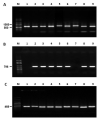Assessment of the Potential of a Native Non-Aflatoxigenic Aspergillus flavus Isolate to Reduce Aflatoxin Contamination in Dairy Feed
- PMID: 35878175
- PMCID: PMC9319854
- DOI: 10.3390/toxins14070437
Assessment of the Potential of a Native Non-Aflatoxigenic Aspergillus flavus Isolate to Reduce Aflatoxin Contamination in Dairy Feed
Abstract
Aspergillus species can produce aflatoxins (AFs), which can severely affect human and animal health. The objective was to evaluate the efficacy of reducing AF contamination of a non-aflatoxigenic isolate of A. flavus experimentally coinoculated with different aflatoxigenic strains in whole plant (WP), corn silage (CS), immature grains (IG) and in culture media (CM). An L-morphotype of A. flavus (CS1) was obtained from CS in a dairy farm located in the Mexican Highland Plateau; The CS1 failed to amplify the AFs biosynthetic pathway regulatory gene (aflR). Monosporic CS1 isolates were coinoculated in WP, CS, IG and CM, together with A. flavus strains with known aflatoxigenic capacity (originating from Cuautitlán and Tamaulipas, Mexico), and native isolates from concentrate feed (CF1, CF2 and CF3) and CS (CS2, CS3). AF production was evaluated by HPLC and fungal growth rate was measured on culture media. The positive control strains and those isolated from CF produced a large average amount of AFs (15,622 ± 3952 and 12,189 ± 3311 µg/kg), whereas A. flavus strains obtained from CS produced a lower AF concentration (126 ± 25.9 µg/kg). CS1 was efficient (p < 0.01) in decreasing AF concentrations when coinoculated together with CF, CS and aflatoxigenic positive control strains (71.6−88.7, 51.0−51.1 and 63.1−71.5%) on WP, CS, IG and CM substrates (73.9−78.2, 65.1−73.7, 63.8−68.4 and 57.4−67.6%). The results suggest that the non-aflatoxigenic isolate can be an effective tool to reduce AF contamination in feed and to minimize the presence of its metabolites in raw milk and dairy products intended for human nutrition.
Keywords: Mexico; aflatoxin biocontrol agents; biological control; dairy cows; mycotoxins.
Conflict of interest statement
The authors declare no conflict of interest.
Figures






Similar articles
-
Aspergillus flavus and Total Aflatoxins Occurrence in Dairy Feed and Aflatoxin M1 in Bovine Milk in Aguascalientes, Mexico.Toxins (Basel). 2022 Apr 20;14(5):292. doi: 10.3390/toxins14050292. Toxins (Basel). 2022. PMID: 35622539 Free PMC article.
-
Characterization and competitive ability of non-aflatoxigenic Aspergillus flavus isolated from the maize agro-ecosystem in Argentina as potential aflatoxin biocontrol agents.Int J Food Microbiol. 2018 Jul 20;277:58-63. doi: 10.1016/j.ijfoodmicro.2018.04.020. Epub 2018 Apr 13. Int J Food Microbiol. 2018. PMID: 29684766
-
Molecular and aflatoxigenicity analyses of Aspergillus flavus isolates indigenous to grain corn in Malaysia; potentials for biological control.J Appl Microbiol. 2024 Jun 3;135(6):lxae145. doi: 10.1093/jambio/lxae145. J Appl Microbiol. 2024. PMID: 38877665
-
Biocontrol of Aflatoxins Using Non-Aflatoxigenic Aspergillus flavus: A Literature Review.J Fungi (Basel). 2021 May 12;7(5):381. doi: 10.3390/jof7050381. J Fungi (Basel). 2021. PMID: 34066260 Free PMC article. Review.
-
Practical considerations will ensure the continued success of pre-harvest biocontrol using non-aflatoxigenic Aspergillus flavus strains.Crit Rev Food Sci Nutr. 2022;62(15):4208-4225. doi: 10.1080/10408398.2021.1873731. Epub 2021 Jan 28. Crit Rev Food Sci Nutr. 2022. PMID: 33506687 Review.
Cited by
-
Application and antagonistic mechanisms of atoxigenic Aspergillus strains for the management of fungal plant diseases.Appl Environ Microbiol. 2024 Oct 23;90(10):e0108524. doi: 10.1128/aem.01085-24. Epub 2024 Sep 17. Appl Environ Microbiol. 2024. PMID: 39287398 Free PMC article. Review.
-
Cadmium and Lead Tolerance of Filamentous Fungi Isolated from Contaminated Mining Soils.Biology (Basel). 2025 Jun 12;14(6):688. doi: 10.3390/biology14060688. Biology (Basel). 2025. PMID: 40563939 Free PMC article.
-
Multi-omics characterization of aflatoxigenic Aspergillus from grains and rhizosphere of maize across agroecological zones of Cameroon.Sci Rep. 2025 May 26;15(1):18407. doi: 10.1038/s41598-025-97296-6. Sci Rep. 2025. PMID: 40419733 Free PMC article.
References
-
- Omara T., Nassazi W., Omute T., Awath A., Laker F., Kalukusu R., Musau B., Nakabuye B.V., Kagoya S., Otim G., et al. Aflatoxins in Uganda: An Encyclopedic Review of the Etiology, Epidemiology, Detection, Quantification, Exposure Assessment, Reduction, and Control. Int. J. Microbiol. 2020;2020:4723612. doi: 10.1155/2020/4723612. - DOI - PMC - PubMed
-
- Hernández-Valdivia E., Valdivia-Flores A.G., Cruz-Vázquez C., Martínez-Saldaña M.C., Quezada-Tristán T., Rangel-Muñoz E.J., Ortiz-Martinez R., Medina-Esparza L.E., Jaramillo-Juarez F. Diagnosis of Subclinical Aflatoxicosis by Biochemical Changes in Dairy Cows Under Field Conditions. Pak. Vet. J. 2020;41:2074–7764. doi: 10.29261/pakvetj/2020.075. - DOI
-
- Walte H.G., Schwake-Anduschus C., Geisen R., Fritsche J. Aflatoxin: Food Chain Transfer from Feed to Milk. J. Fur. Ver-Braucherschutz Leb. 2016;11:295–297. doi: 10.1007/s00003-016-1059-8. - DOI
-
- Martínez-Tozcano L.J., Juárez-Atonal R., Nava Galicia S.B., Garrido-Bazán V., Bibbins-Martínez M. Aflatoxins, A Silent Danger? [(accessed on 12 May 2022)];Front. Biotecnol. 2021 20:16–20. Available online: https://www.revistafronterabiotecnologica.cibatlaxcala.ipn.mx/volumen/vo....
Publication types
MeSH terms
Substances
LinkOut - more resources
Full Text Sources
Miscellaneous

